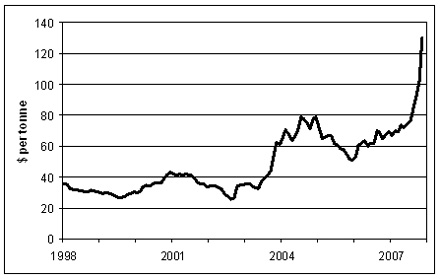Global Solar Power Map #14
India and Indian Ocean

Calgary by night

In front with Bow River
Coal Price

Increasing rapidly like Oil Price
Average Price of Electricity with Solar panel cost at $1/Wp as of now 2010 Violet curve

Sunday, November 7, 2010
Saturday, November 6, 2010
pv_roadmap.pdf (application/pdf Object)
Technology Roadmap 2010 - Solar photovoltaic energy
by The International Energy Agency
Solar PV power is a commercially available and reliable technology with a significant potential for long-term growth in nearly all world regions. This roadmap estimates that by 2050, PV will provide around 11% of global electricity production and avoid 2.3 gigatonnes (Gt) of CO2 emissions per year.
More needs to be done to foster rural electrification and capacity building. Multilateral and bilateral aid organisations should expand their efforts to express the value of PV energy in low-carbon economic development.



Thursday, November 4, 2010
REC reveals fully integrated manufacturing cost per watt roadmap - Photovoltaics International
REC reveals fully integrated manufacturing cost per watt roadmap

An ambitious plan, which hasn’t been without implementation issues and which has stretched the financial structure of REC Group, is finally bearing fruit according to key executives of the company. At a lengthy investor and analyst seminar being held in Singapore, coinciding with the grand opening of the company's €1.3 billion plus integrated module production facility, enigmatic CEO Ole Enger claimed REC was on track to deliver a companywide all inclusive cost of €0.97/watt by the fourth quarter 2011. Excluding equipment and building depreciation at the new plant, the cash cost target for next year would be €0.74/watt.
Part of the €3 billion plus capital expenditure program is the polysilicon and silane capacity expansions involved in the the buildout and ramp of its low-cost, fluidized bed reactor (FBR) technology in North America. The company's polysilicon achieved a fully inclusive cost of US$42/kg in the third quarter and has a target of US$31/kg by the fourth-quarter 2011, as production reaches 16,000MT per annum, according to REC.
Enger noted in the seminar that REC had demonstrated a cash manufacturing cost for the FBR-processed polysilicon of US$18/kg.
With the ramps under way and a period of optimization and debottlenecking planned for 2011, REC is confident that it has the manufacturing cost structure to compete with anyone in the PV industry, not least the low-cost Tier 1 producers in China.
REC plans to further leverage investments in infrastructure at the Singapore site to increase module production to 800MW by 2012, exceeding the nameplate capacity by approximately 35%. Importantly, this was claimed to be achievable without further significant capital cost.
Indeed the plant in Singapore is at the heart of its claims for longer-term cost competitiveness. The highly automated plant uses a skilled workforce but employs less than 50% of the number typically found in Tier 1 plants in China.
Although the upfront cost of highly automated module plants and heavy tool depreciation costs can prove challenging to compete with the cost structures found in China, REC highlighted that cell breakage in Singapore was already as low as 0.4% using a standardized 180µm wafer thickness. Silicon consumption from ingot to module is expected to be down to 5.6g/watt by the fourth quarter of 2010.
The elimination of as many pick-and-place handling robots as possible throughout the facility was said to be behind the low breakage figure. Only four were being used within the plant, compared to 18 being used at a similar plant in Norway, according to the company. Wafer quality has also been a key factor in REC’s cost competitive roadmap. Erik Lokke-Owre, senior VP of operations in Singapore, noted in his presentation that the plant had already achieved a 0.2-0.3% wafer quality improvement that contributes to an overall annual cost reduction cycle of an expected 10% per annum.
Wafer quality has also been a key factor in REC’s cost competitive roadmap. Erik Lokke-Owre, senior VP of operations in Singapore, noted in his presentation that the plant had already achieved a 0.2-0.3% wafer quality improvement that contributes to an overall annual cost reduction cycle of an expected 10% per annum.
The plant also includes eight advanced cell lines, each with a nameplate capacity of 70MW, giving REC a total of 550MW. Near-zero defects and perfect manufacturing flow dynamics were at the core of its competitive position, Lokke-Owre added.
Average cell efficiencies were pegged at 16.8% without further planned enhancements and process optimization, while current yields have exceeded 94%. The use of advanced process control (APC) and statistical process control (SPC) systems and protocols would ensure quality cells at a world-class level, he said.
Solar module costs were said to be on target to fall to €1.05/watt by the fourth quarter of 2011, down from €1.49/watt in the third quarter of 2010, representing a 30% decline over five quarters.
REC executives also noted that sales demand is expected to be strong in 2011, giving the company confidence in achieving full capacity for its FBR silicon and Singapore plants.
"I am impressed by the performance demonstrated by the Singapore organization during construction and ramp-up of the new facility," noted Enger. “This achievement gives me confidence in the organization's ability to continue to improve and further strengthen REC's competitive position.”
Sunday, October 31, 2010
Friday, October 29, 2010
Wednesday, October 27, 2010
European PhotoVoltaic Industry Association (EPIA): EPIA Publications
Solar Generation 6 - Executive SummaryDate: October 2010 |  |
| This publication is the sixth edition of the reference global solar scenarios that have been established by the European Photovoltaic Industry Association (EPIA) and Greenpeace jointly for almost ten years. It provides well documented scenarios establishing the PV deployment potential world-wide by 2050. The Solar Generation Paradigm Shift Scenario predicts that by 2050, PV could generate enough solar electricity to satisfy 21% of the world electricity needs. This represents a total of 2,260 TWh of solar PV electricity in 2030 and up to 6750 TWh in 2050. This would come from an installed capacity of 1845 GW in 2030 and 4670 GW in 2050, to be compared with 23 GW installed in the world at the end of 2009.
| |
Photovoltaic Observatory - Policy recommendationsDate: September 2010 |  |
| | |
Unlocking the Sunbelt Potential of PhotovoltaicsDate: September 2010 |  |
| This report presents findings regarding possible scenarios under which the Sunbelt PV potential could be unlocked, namely, the Base, the Accelerated and the Paradigm shift. The study further examines the countries which might be first in line to do so, given the attractiveness of PV for their economies and the overall investment climate they offer. The result is graphically summarised in Figure 1, showing PV potential of 66 Sunbelt countries that jointly constitute one large Sunbelt PV potential. This underlines two main messages: while PV potential differs depending on country size and suitability, there is significant potential in every country of the Sunbelt. And jointly, the PV potential of Sunbelt countries amounts to a major contribution to satisfy power demand and decrease the world’s dependency on conventional fuel sources. | |
Global Market Outlook for Photovoltaics Until 2014Date: May 2010 |  |
| The European Photovoltaic Industry Association (EPIA) has just released its publication “Global Market Outlook for Photovoltaics until 2014”. The publication provides detailed figures for the 2009 market and an outlook on the global and main markets until 2014. In 2009, the global solar photovoltaic (PV) market reached 7.2 GW and the cumulative PV power installed totaled over 22 GW world-wide compared to 15 GW in 2008. With around 3.8 GW of newly-installed PV power, Germany remained the largest market in 2009, followed by Italy with 730 MW of additional capacity in the last year. | |
EPIA Annual Report 2009Date: April 2010 |  |
| Although 2009 will remain financially as the worst year since the 1929 crisis, the Global photovoltaic (PV) industry did not go through the same turmoil as conventional industries. One could feel this dynamic especially at our last 24th EU PVSEC in Hamburg which registered a new record number of participants and exhibitors. However 2009 has been prefiguring many challenges that will have to be faced this year and in the coming ones. With the boom of the German market in wait of a feed-in tariff review, the global market size has maintained a positive growth; however it is more than ever essential that our sector does not rely on one single market. It will be vital in 2010 to keep existing markets going and make sure to open new and substantial ones inside and outside Europe.
| |
Photovoltaic energy, electricity from the sunDate: April 2010 |  |
| This general publication about solar Photovoltaic electricity is dedicated to the widest audience and has been published in the frame of the Solar Days, held on the 15 and 16 May 2008, and updated in March 2010. | |
Tuesday, October 26, 2010
What happens when the subsidies stop? - Photovoltaics World
The figure below traces PV industry pricing through 2010. The data are assessed by buying category (large volume buyers receive the largest discount), and include a global weighted average and a weighted average across buying categories. The analysis is based on the mother of all weighted averages.

The table below shows the rise of manufacturing strength outside of the US, as shipments from technology manufacturers to the first point of sale in the market. The ROW region includes technology manufacturers from Malaysia, the Philippines, India, and Singapore, and other countries.
 |
| Regional shipments 2005-2010, in MWp. |
Thursday, October 21, 2010
Monday, October 4, 2010
First Solar CEO betting on U.S. as Germany fades | Reuters
Has plans to start construction next year on its biggest yet: the 290 megawatt Agua Caliente plant in California.
Thin film modules, which are being used to power projects such as the 80-MW plant in Sarnia, Ontario, owned by Enbridge, and the 58-MW Copper Mountain, Nevada, plant that is owned by Sempra Energy.
Sunday, October 3, 2010
Help us get Facebook to unfriend coal | Greenpeace International
- Commit to stop using polluting coal power,
- Use its purchasing power to choose only clean, renewable sources of electricity,
- Advocate for strong climate and energy policy changes at the local, national and international level to ensure that as the IT industry's energy demand increases, so does the supply of renewable energy,
- Share this information publicly on its website so its millions of users know the company is a climate leader.
Saturday, October 2, 2010
You In Control?
Motivation and control are important qualities to hone as
you strive to become a more grounded and successful person.
These qualities are aspects of a character that is geared
towards working hard for success and handling setbacks
calmly.
When you can harness your motivation you will be able to
push yourself harder and enjoy your work more with each
passing day.
Harnessing both qualities and making them work for you
takes practice, but listed below are some techniques to
help you find and work with your own motivation and control.
1. Understand your motivation better by brainstorming your
goals and desires.
What we want in life and where we are hoping to go
influences the decisions we make and the roads we choose.
When you understand your desires and have delineated your
goals, you can begin to understand what is motivating you
and then can make that motivation work for your ultimate
purposes more effectively.
Make a list of your goals and dreams and look for
similarities between them. These similarities are part of
your motivation and control plan.
2. Practice your control over yourself and your emotions.
Someone who can maintain self-control in the face of
setbacks will be more able to rebound and rectify the
situation.
When you are in touch with your own center of self-control,
you can soothe yourself and calm yourself just as a mother
soothes a crying child.
You know yourself better than anyone, and can learn to make
yourself feel better when stress or anxiety threaten your
peace of mind.
The ability to maintain self control in unhappy situations
will reduce additional damage done to the situation by bad
attitude or actions resulting from anger.
3. When you are tired or having a hard time paying
attention, remember your motivation to fuel your control.
Motivation can produce the necessary fuel to enable you to
be more controlled and efficient.
When you just do not see why you should complete a task,
let your motivation inspire you to work at the control that
comes so easily on other days.
What Winners Do Automatically
There will be days when it does not come easily to be a
winner. On these days, you must harness your motivation and
work to maintain your control.
By using the one to stimulate the other, you will be making
effective use of these qualities and honing them to develop
motivation and control and become stronger at the same time.
Motivation and control are necessary to achieve the height
of success and fulfillment you are looking for. These
qualities are not always easy to maintain or to achieve,
but they are worth working at on the off days.
When you are able to work at these qualities and keep them
in mind, you will be able to conquer tougher projects than
you ever imagined and succeed.
The Missing Key To Success For Many
Motivation and control is the key to reaching heights and
goals you never thought you could manage.
True motivation is not only a learned skill; it is
developed due to a need or desire to make our dreams a
reality.
If you want to find inner motivation, you must identify
your goals and set out on an unwavering path to achieve
them.
You Can Unlock Your True Abilities
Overcoming procrastination is perhaps one of the most
important steps you can take to improve your life and
become the motivated, successful person you are capable of
being.
You have to let go of your old personality and ways of
doing things to change, quit procrastinating and get
motivated!
Wednesday, September 1, 2010
Saturday, August 21, 2010
Thursday, August 19, 2010
Saturday, July 17, 2010
Thursday, July 8, 2010
Thursday, July 1, 2010
Sai Baba Tamil Song with English subtitles. நல்ல ஒரு சாய் பாபா தமிழ் பாடல். on Vimeo
A video presentation made for the SAI BABA Birthday Celebrations in Calgary in 2007. A very nice Song from Toronto. Video prepared by Dr.Vidya from U of C and Translation checked by Dr V Nallainayagam
Thanks are to all of them. நன்றி
Sunday, June 27, 2010
Thursday, June 24, 2010
SunPower Sets Solar Cell Efficiency Record at 24.2% | Renewable Energy World
SunPower also announced that has reached a deal with French retailer Casino Group for the supply of 20 megawatts (MW) of solar photovoltaic panels for solar power installations on Casino Group properties in mainland France.



 Alberta Time
Alberta Time